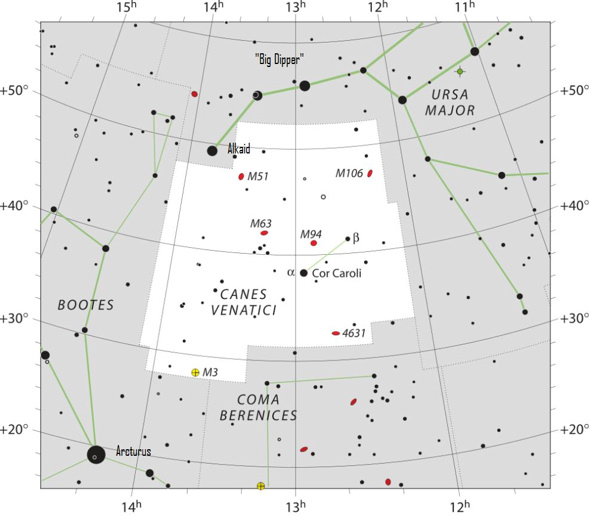
Cor Caroli
Cor Caroli – aka Alpha Canum Venaticorum – is the brightest star in the constellation Canes Venatici the Hunting Dogs. This star, and Chara, Canes Venatici’s 2nd-brightest star, are probably the only two stars you’ll ever come to know within the boundaries of this tiny constellation. You can pick out the pair easily if your sky is dark enough.
Although they aren’t among the sky’s brightest stars, Cor Caroli and Chara are relatively easy to find, due to their relationship on the sky’s dome to the famous Big Dipper. This well-known asterism is ascending in the northeast on spring evenings. The two stars of Canes Venatici appear snuggled together, near the handle of the Dipper.
Heart of Charles
Cor Caroli means Heart of Charles. Some say the star was named to honor King Charles I of England, who was beheaded in 1649 during the English Civil War. These sources claim Cor Caroli was labeled on old star charts as Cor Caroli Regis Martyris, or Heart of Charles the Martyr King.
Not everyone agrees, however. Others say the star was named for Charles I’s son, Charles II. Sir Charles Scarborough, physician to Charles II, is sometimes given credit for having coined the name. It’s said Scarborough claimed the star shone with exceptional brilliance on the night of Charles II’s return to England in 1660 to restore the monarchy.
It’s really 2 stars
If you use a small telescope, you’ll see that Cor Caroli is a double star. So it’s easy to imagine father and son peacefully reunited in the heavens, after all their tumultuous years on Earth.
And Cor Caroli doesn’t just appear double. It’s a true binary star, consisting of two stars revolving around a common center of mass. The pair lies some 115 light-years away. This is slightly farther away from us than the stars in the Big Dipper.
One orbital period may take as long as 8,300 years. The fainter star lies 19 arcseconds away and to the southwest of the brighter star. The stars are about 5 light-years apart, with the brighter star closer to us than the fainter star. The brighter star varies in brightness every 5.47 days from magnitude 2.84 to 2.98. The fainter companion shines at magnitude 5.6.
You can see this double star for yourself on the next clear evening. Binoculars won’t magnify enough to split the star into its two components. But a small telescope using at least 40 power will show the object as two stars. A large telescope using even more magnification will reveal the colors of the two stars. The brighter star is white or blue-white. The fainter star is more difficult to discern, but some observers see it as mild lilac in color.
The 2 stars are very different
The fainter star is Alpha-1 and the brighter star is Alpha-2. One would think that the brighter star would be #1 and the fainter star would be #2. But stars are numbered from west to east and the fainter star is west of the brighter star.
Alpha-2 is a hot star, spectral type A, with a temperature of 11,600 kelvins or 20,420 degrees Fahrenheit or 11,326 degrees Celsius (in contrast with our sun’s surface temperature of 6,000 kelvins or 10,340 F or 5,726 C). In other words, Cor Caroli shines 100 times brighter than our sun and is nearly three times larger than our sun.
This bright variable star is the namesake for a certain class of stars known as Alpha2 Canum Venaticorum variables. These are heavy metal stars with very strong magnetic fields. “Metals,” in a star, refers to elements more complex than hydrogen or helium. In Cor Caroli, the metals are concentrated in starspots, and are not evenly distributed in the star’s atmosphere. And so, as the star rotates, its brightness varies from our point of view.
The fainter of the two stars in Cor Caroli, Alpha-1, is nearly as cool as our sun at 7,800 kelvins (12,284 F/ 6,806 C). It’s only five times brighter than our sun, and nearly twice as large. Its spectral class is F.

Bottom line: The star Cor Caroli, or Alpha Canum Venaticorum, is a binary star and the brightest star in the northern constellation Canes Venatici the Hunting Dogs. Both components are visible in a small telescope.
Enjoying EarthSky? Sign up for our free daily newsletter today!











